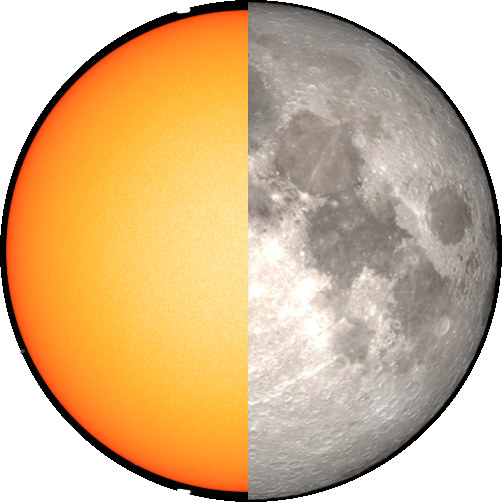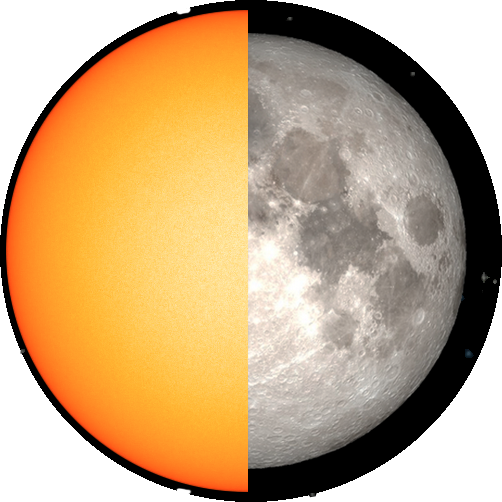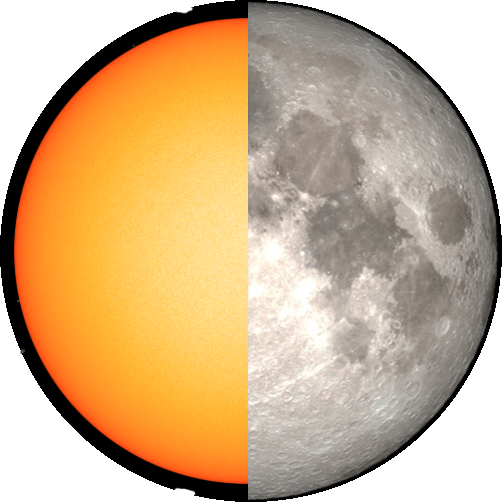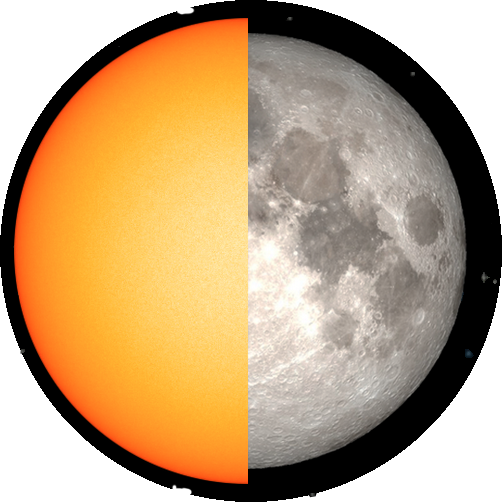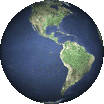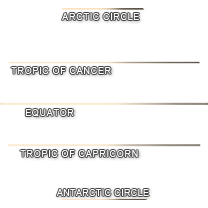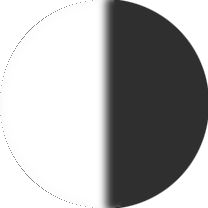
CURRENT APPARENT SIZES OF THE SUN & MOON (geocentric)

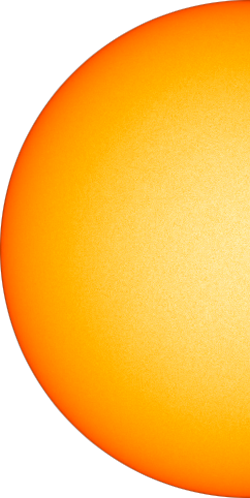
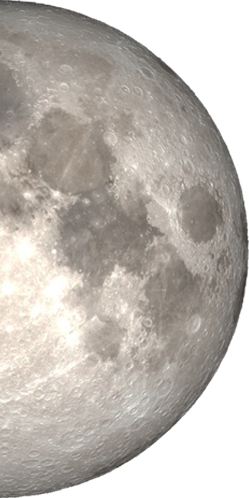

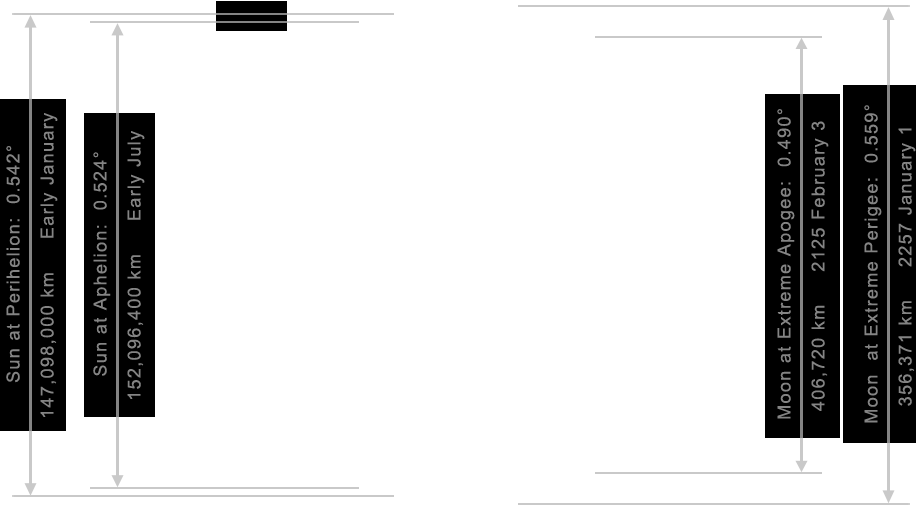

KEEP SAFE! 
 W A R N I N G ! It is never NEVER safe to look directly at the real Sun with the naked eye! Moreover, looking at it—even for an instant— through a telescope, binoculars, camera or similar instrument without adequate safeguards can cause permanent blindness! NEVER DO IT! To learn how you can safely "observe" the Sun, consult the pro- fessionals at your local planetarium or observatory.
W A R N I N G ! It is never NEVER safe to look directly at the real Sun with the naked eye! Moreover, looking at it—even for an instant— through a telescope, binoculars, camera or similar instrument without adequate safeguards can cause permanent blindness! NEVER DO IT! To learn how you can safely "observe" the Sun, consult the pro- fessionals at your local planetarium or observatory.
2025 May 7 10:45 PM Local Time = 2025 May 7 22:45 UTC
SUN SIZE: 0.528° (to update, reload page) MOON SIZE: 0.495°

Current: 1.0092 AU
8.39 lt-min

Earth's Mean Tilt Today
16.81°
relative to the Sun

Sun Distances (in Astronomical Units):
Perihelion = 0.9833, Average Distance = 1.0000, Aphelion = 1.0167
It is an intriguing "cosmic coincidence" that the Sun, with a diameter about 400 times that of the Moon, is about 400 times farther than the Moon from Earth! This makes the two most prominent celestial bodies in our sky look very similar in size from our planet. However, the apparent sizes of the Sun and Moon are not constant—the Sun appearing to grow and shrink due to Earth's elliptical orbit, the Moon due to its own elliptical yet far more complex orbit. The views accessible at the top reveal how great these changes can be, while the accompanying side views of Earth's and the Moon's orbits show the current distances of 1.) our planet from the Sun, and 2.) the Moon from Earth. Light-times too are given, and the view of the lunar orbit lets you send a photon to the Moon and back, showing that even communication with our nearest neighbor is not instantaneous!

Current: 31.5 Earth Diameters
1.34 light-seconds
![]()
Moon Distances (in Earth equatorial diameters):
Min Perigee = 27.9, Average Distance = 30.1, Max Apogee = 31.9
Together these views highlight how the current solar and lunar apparent sizes depend on the current distances of the Sun and the Moon from Earth, and—as we'll soon see—they can be particularly useful in predicting the charac- teristics of an upcoming eclipse! You'll find that the Moon's apparent size varies quite a bit more than the Sun's. This is because on average the Moon's orbit around Earth is over 3 times more eccentric than Earth's orbit around the Sun! The side views of Earth's and the Moon's orbits confirm this, showing very
clearly that—in proportion to their orbits' overall sizes—the "variation" in the Earth-
Moon distance is significantly greater than the "variation" in the Sun-Earth distance.
Shown to the right, on average the Sun looks
just slightly larger than the Moon, their average
apparent diameters 0.533° vs 0.518° respectively.

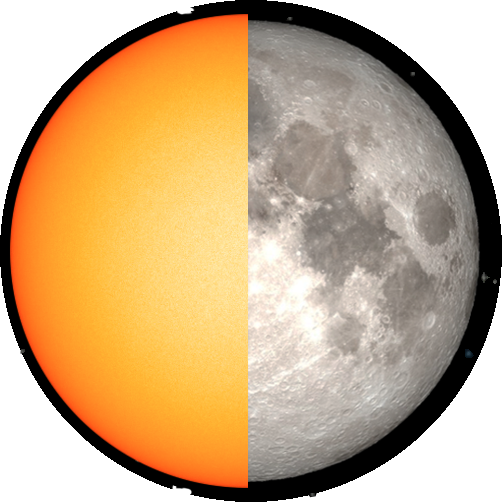
As you can verify at the top of this page, if both bodies are compared at their maxi-
mum apparent diameters, the Moon looks larger, whereas at their minimum apparent
diameters the Sun looks larger. Of course, the various comparative Moon views avail-
able at the top are simplified for clarity. So neither the current lunar phase nor the current lunar libration ![]() are displayed. Nonetheless, these comparative views can tell us a lot. For example, over time the variations in the "current" views confirm that the Moon's apparent size changes over 12 times faster than the Sun's! This should come as no surprise, since the Moon orbits Earth about once a month, while Earth orbits the Sun only once a year.
are displayed. Nonetheless, these comparative views can tell us a lot. For example, over time the variations in the "current" views confirm that the Moon's apparent size changes over 12 times faster than the Sun's! This should come as no surprise, since the Moon orbits Earth about once a month, while Earth orbits the Sun only once a year.
| EARTH'S ORBIT AROUND THE SUN | MOON'S ORBIT AROUND EARTH |
|---|---|
| Periods: (Years) Sidereal: 365.2564 days (rel. to the stars) Tropical: 365.2422 days (rel. to equinox) Julian: 365.25 days (astronomical computation) Distance: Mean: 1 AU (essentially defines measurement) Mean: 149,597,870.7 km (defined in 2012) Dates of: early April & early October Perihelion: 147,098,300 km (0.9833 AU) Date of: betw. Jan 2 and Jan 6 Aphelion: 152,097,400 km (1.0167 AU) Date of: betw. Jul 3 and Jul 7 Eccentricity: 0.0167 |
Periods: (Months) Sidereal: 27.32166 days (rel. to the stars) Synodic: 29.53059 days (rel. to Sun, Phases) Anomalistic: 27.55455 days (rel. to Perigee) Distance: (Earth diameters are "equatorial") Mean: 384,400 km (30.13 Earth dia.) Perigee: Mean: 363,300 km Min: 356,371 km (27.9 Earth dia.) Apogee: Mean: 405,500 km Max: 406,720 km (31.9 Earth dia.) Eccentricity: 0.0549 (mean); 0.0255 - 0.0775 |
As you will discover, about every 27 1/2 days—on average—the Moon's apparent diameter grows larger than the Sun's, at times as much as 6 1/2 percent larger! However, the Moon's orbit around Earth is quite complex, far more complex than Earth's orbit around the Sun! While Earth's "variations" in perihelion and aphelion are small (less than 0.02%) and have minor effect, the Moon's "variations" in perigee and apogee are not insignificant. Lunar perigees vary by over 3.5%! So, on occasion the Moon can pass through perigee yet still appear smaller than the Sun—though only from part of Earth! Because Earth is a sphere, parts of its surface are closer to the Moon than others. So, even at the most distant lunar perigees, on the side of Earth facing the Moon is a bowl-shaped region from which the Moon looks just slightly larger than the Sun. But from the "ring" around this "bowl", the Moon still looks smaller. This occurred on 2019 Dec 18, when the lunar perigee's distance from Earth was over 370,255 km, near the maximum possible for any lunar orbit! These "more-distant" lunar perigees, where the Moon—for a full orbit—looks smaller than the Sun from part of Earth, recur about every 13 to 15 months. Even so, it is the opposite situation, when perigee distances shrink and the Moon is "closer" than usual to Earth, that can have consequential effects. At such times the Moon's gravitational pull on Earth increases by an amount that can be significant, and—as the graph below shows—it can result in Extreme Perigean Tides ![]() . Such higher-than-normal tides can sub- stantially exacerbate shore erosion, especially if they coincide with strong storms! (Note: the term Supermoon
. Such higher-than-normal tides can sub- stantially exacerbate shore erosion, especially if they coincide with strong storms! (Note: the term Supermoon ![]() has come into use relatively recently to describe a Full Moon which occurs near an extreme lunar perigee. While this term as yet has no rigorous astronomical definition, it is becoming popular in weather reports.)
has come into use relatively recently to describe a Full Moon which occurs near an extreme lunar perigee. While this term as yet has no rigorous astronomical definition, it is becoming popular in weather reports.)

Supermoons & Extreme Perigean Tides 2020-2022
With the graph above, which plots the lunar distance from 2020 through 2022, you can obtain a good sense of whether the Moon should appear larger or smaller than average at a particular time. In addition, you can use this Lunar Perigee and Apogee Calculator to study how the Moon's least and greatest distances from Earth vary from month to month. The excellent AstroPixels site provides a 100-year Perigee & Apogee List that can help with this too. (That site has a 100-year Perihelion & Aphelion List as well.) With these resources you can also determine how close this year's lunar perigees and apogees approach their historical extremes. The values of the extreme minimum perigee and extreme maximum apogee of the Moon—shown in the interactive Sun-Moon diagram at the top of the page—are those computed by noted astro-mathmatician Jean Meeus for the years from CE 1500 - 2500. However, as the graph above reveals, in just three months lunar perigees can vary by well over 10,000 kilometers! This demonstrates just how inconstant the Moon's orbit—and especially its perigees—can be, a clear reminder
that in any given month the Moon may not approach anything near its historical minimum distance!
Now, if you like to measure things like screen images, then the "Average Sizes of Sun & Moon" at the top of this page may intrigue you. The Moon's average apparent size is not "halfway" between its maximum and minimum sizes, but a bit smaller! This is because the Moon's average distance of 384,400 km is not "halfway" between its extreme perigee and apogee distances! Near the top, the side view of the Moon's orbit also confirms this. The reason can be seen in the graph above. It is apparent that successive lunar perigees vary considerably more than lunar apogees, so on average the Moon spends more time father from Earth than "halfway" between its extremes of perigee and apogee! The average lunar apparent size reflects this.
Knowing the current relative apparent sizes of the Sun and the Moon can be quite helpful during Eclipse Seasons. How large the Sun and Moon appear can suggest if an upcoming solar eclipse may be Total, Annular or Hybrid.
It is in early January when the Sun and Moon "can" appear most unequal in size to us. This is when the Sun is "nearest" (yes, "nearest"!) to Earth and thus looks its largest in our sky. Near this time, if the Moon is its "farthest" from Earth and thus looks its smallest, it cannot "cover up" as much of the Sun if a solar eclipse occurs. Also, because the Moon is at apogee, it is moving slower than at any other point in its orbit. The result of all this is that the longest Annular Solar Eclipses—at rare times exceeding 12 minutes—occur near a year's beginning or end. In contrast, the Sun is its "farthest" from Earth and smallest in our sky in early July. Near this time, if the Moon is its "closest" to Earth and thus looks its largest, it can hide the Sun to the greatest degree if a solar eclipse occurs. So the longest Total Solar Eclipses—at rare times almost 7½ minutes long—occur near mid-year! Of course, as the figures at the top of this page show, the "maximum possible" size differences between the Moon and Sun are less in July for Total Solar Eclipses (0.559° - 0.524° = 0.035°) than in January for Annular ones (0.542° - 0.490° = 0.052°). This is one reason why the longest Total Solar Eclipses are shorter than the longest Annular ones. Another is that, when it covers the Sun most greatly, the Moon is at or near perigee, so its higher speed shortens the Total Eclipses it produces. Hover over the image directly below for a visual comparison of these circumstances.


Near the top of the page we saw how the side view of Earth's orbit shows the current position of our planet between perihelion and aphelion. In a related way the map of the Inner Solar System below shows Earth's current position in orbit, giving you another way to see how close our planet is to these orbital extremes. To make this easier to visu- alize, the grid has been rotated to align it with the Line of Apsides of Earth's orbit, i.e. the line joining its perihelion and aphelion. Given the map below and the diagrams above, you can even check one against the others and see if they agree! (They should!) Meanwhile, don't forget to also check out the Current Apparent Sizes of the Planets.
2025 May 7 10:45 PM Local Time = 2025 May 7 22:45 UTC
Sun-Earth Current Distance: 1.0092 AU
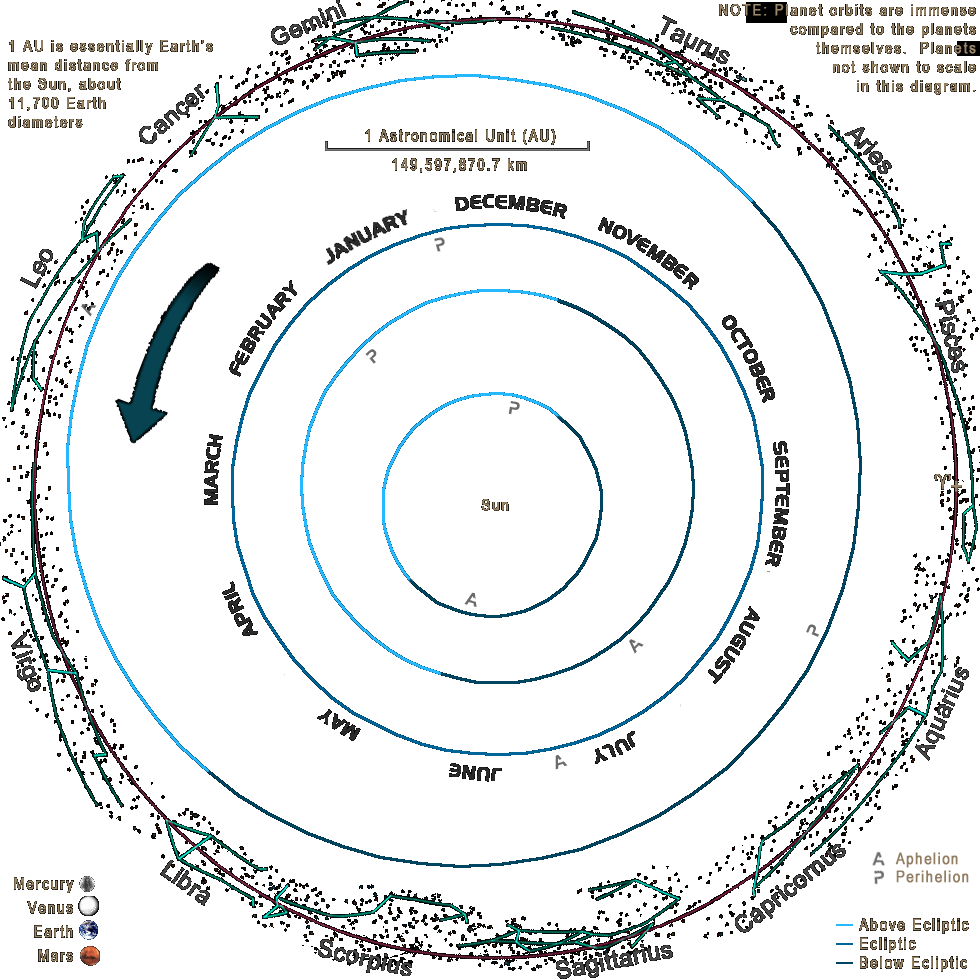
Finally, as all of the above deals with the "apparent" sizes of the Sun and the Moon, it seems that—for comparison —an image of Earth, the Sun, and the Moon together in their relative "absolute" sizes is appropriate here as well. Look closely. The Moon—its diameter 1/400th that of the Sun (remember?)—is hard to see. An "edge-on" view of the lunar orbit is also included, shown with its average radius of 384,400 km. And in case you may be wondering, yes, those are the actual sunspots visible from Earth in the SDO video of the Sun that day!
Current Sunspots
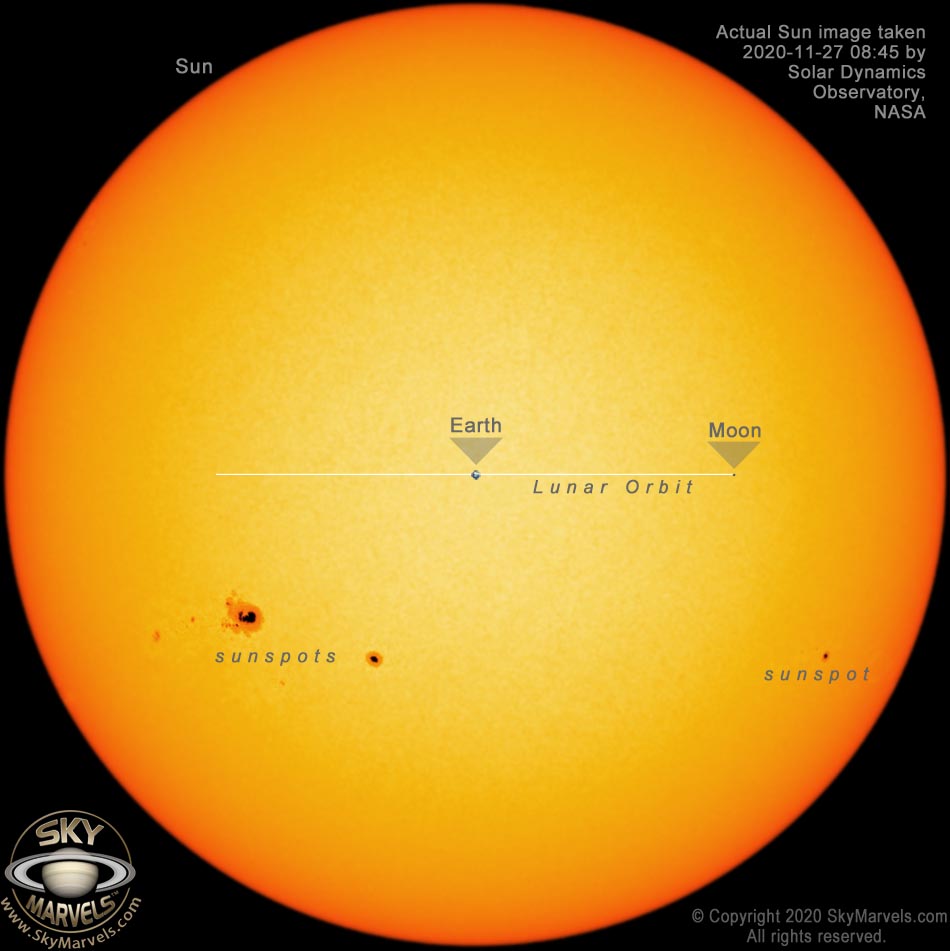
Home Intro News Gallery Sky-Gifts Bonuses Tips
Learning Ctr Help Links Credits Legal Contact Us
© 2007-
2025
by Gary M. Winter. All rights reserved.
Interested in political cartoons and humor?
Check out The HIPPLOMATS™.
SkyMarvels, Sky Marvels, SkyMarvels.com, SkyMarvels, Sky Marvels, SkyMarvels.com, Current Sunsize vs Moonsize, SUN and MOON Current Apparent Sizes, Current Geocentric Apparent Sizes of the Sun and Moon. celestia4all, celestiaforall, CELESTIA, astronomy, space, simulations, animations, downloadable astronomy posters, stars, planets, Inner Planets, Outer Planets, Inferior Planets, Superior Planets, moons, asteroids, comets, Oort Cloud, galaxy, galaxies, Milky Way, Andromeda, globular clusters, binaries, quasars, black holes, supermassive black holes, telescope, telescopes, planetarium, software, freestuff, satellites, add-ons, addons, scripts, eclipses, Solar Eclipses, Lunar Eclipses, Solar Eclipse Finder, Lunar Eclipse Finder, mutual eclipses, transits, occultations, Solar System, CELES-TOOLS, celeSTARrium, CELX, CELX programming, Freebies, multiple views, atronomical unit, light year, parsec, meteors, meteor showers, Perseids, Geminids, Leonids, barycenter, time, Time Zones, tides, alignments, conjunctions, oppositions, seasons, apogees, perigees, aphelion, perihelion, Earth, Luna, Mercury, Venus, Mars, Jupiter, Galilean Moons, Io, Europa, Ganymede, Callisto, Saturn, Titan, rings, Uranus, Neptune, Triton, E-MSpectrum, electromagnetic spectrum, astronaut, equinoxes, solstices, precession, rotation, spin, inclination, tilt, Ecliptic, orbits, ellipse, parabola, hyperbola

